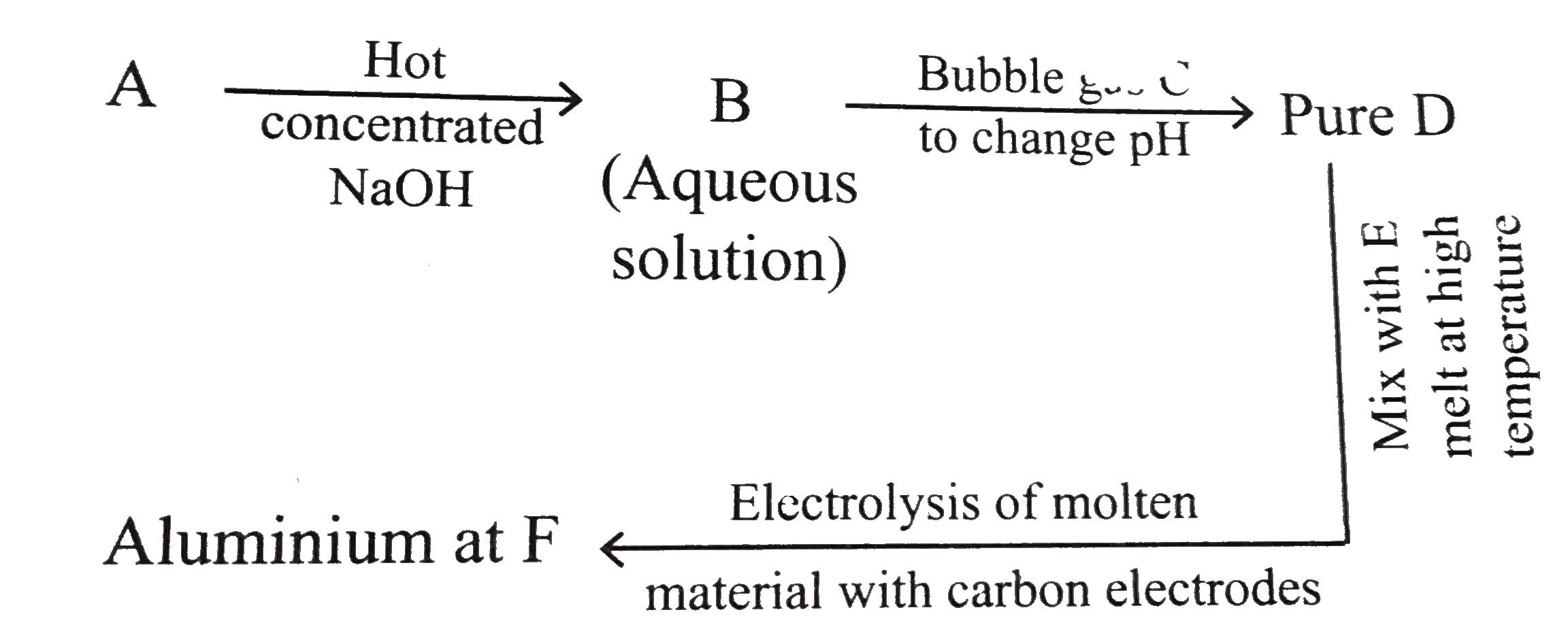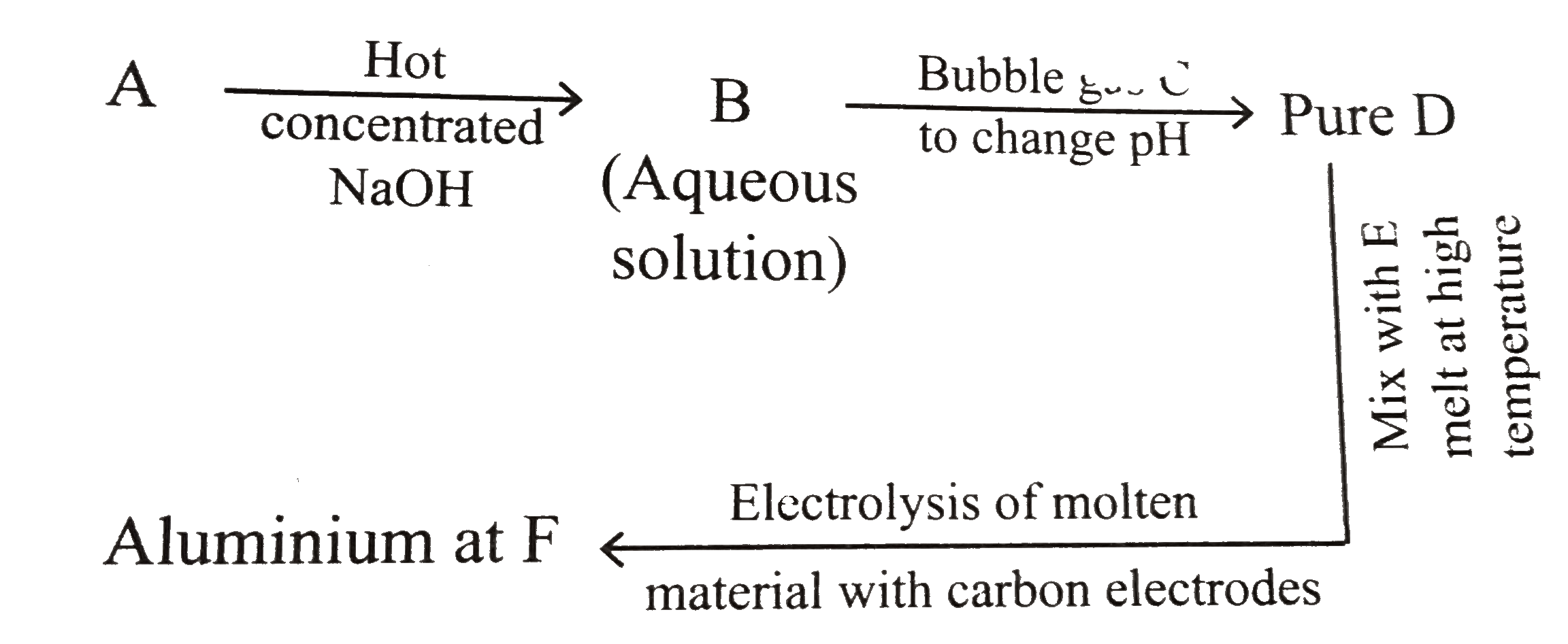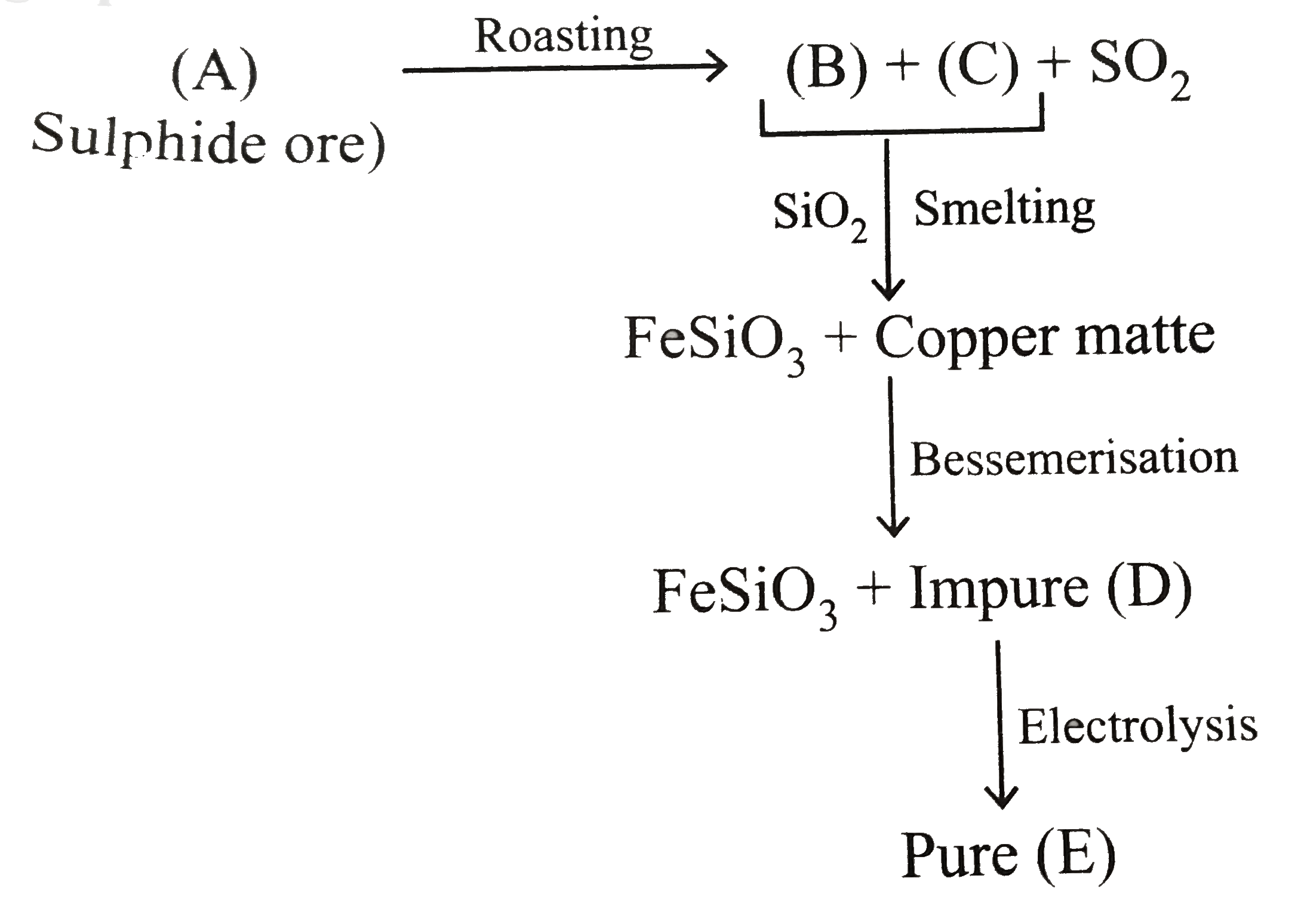Complete Solutions to Exercises (Linked Comprehension) of chapter GENERAL PRINCIPLES AND PROCESS OF ISOLATION OF ELEMENTS of Class 12 book with complete answers and questions
| Class 12 | CHEMISTRY |
| Chapter | GENERAL PRINCIPLES AND PROCESS OF ISOLATION OF ELEMENTS |
| CENGAGE CHEMISTRY | Exercises (Linked Comprehension) |
| Number Of Questions | 42 |
| Academic Year | 2023-24 |
Copper is the most noble of first row transition metals and occurs in small deposits in serveral countries. Ores of copper include chalcanthite `(CuSO_(4).5H_(2)O)`, atacanite `[Cu_(2)Cl(OH)_(3)]`, cuprite `(Cu_(2)O)`, copper glance `(Cu_(2)S)`, and malachite `[Cu_(2)(OH)_(2)CO_(3)]`. However, `80 %` of the world copper production comes from the ore chalcopyrite `(CuFeS_(2))`. The extraction of copper from chalcopyrite involves partial roasting, removal of iron and self-reduction.
Partial roasting of chalcopyrite produces
View SolutionCopper is the most noble of first row transition metals and occurs in small deposits in serveral countries. Ores of copper include chalcanthite `(CuSO_(4).5H_(2)O)`, atacanite `[Cu_(2)Cl(OH)_(3)]`, cuprite `(Cu_(2)O)`, copper glance `(Cu_(2)S)`, and malachite `[Cu_(2)(OH)_(2)CO_(3)]`. However, `80 %` of the world copper production comes from the ore chalcopyrite `(CuFeS_(2))`. The extraction of copper from chalcopyrite involves partial roasting, removal of iron and self-reduction.
Iron is removed from chalcopyrite as.
View SolutionCopper is the most noble of first row transition metals and occurs in small deposits in serveral countries. Ores of copper include chalcanthite `(CuSO_(4).5H_(2)O)`, atacanite `[Cu_(2)Cl(OH)_(3)]`, cuprite `(Cu_(2)O)`, copper glance `(Cu_(2)S)`, and malachite `[Cu_(2)(OH)_(2)CO_(3)]`. However, `80 %` of the world copper production comes from the ore chalcopyrite `(CuFeS_(2))`. The extraction of copper from chalcopyrite involves partial roasting, removal of iron and self-reduction.
In self-reduction, the reducing species is.
View SolutionExtraction of copper is done using copper pyrites. After roasting, the ore is mixed with silica and coke and then smelted in a blast furnace. The matte obtained from the blast furnace is charged into a silica-lined converter. Some silica is also added, and a hot air blast is blown into the mixture to obtain blister copper, which is purified by electrorefining.
The chemical formula of copper pyrites is.
View SolutionExtraction of copper is done using copper pyrites. After roasting, the ore is mixed with silica and coke and then smelted in a blast furnace. The matte obtained from the blast furnace is charged into a silica-lined converter. Some silica is also added, and a hot air blast is blown into the mixture to obtain blister copper, which is purified by electrorefining.
The chemical composition of the slag formed during smelting is.
View SolutionExtraction of copper is done using copper pyrites. After roasting, the ore is mixed with silica and coke and then smelted in a blast furnace. The matte obtained from the blast furnace is charged into a silica-lined converter. Some silica is also added, and a hot air blast is blown into the mixture to obtain blister copper, which is purified by electrorefining.
Coke is added during smelting to.
View SolutionExtraction of copper is done using copper pyrites. After roasting, the ore is mixed with silica and coke and then smelted in a blast furnace. The matte obtained from the blast furnace is charged into a silica-lined converter. Some silica is also added, and a hot air blast is blown into the mixture to obtain blister copper, which is purified by electrorefining.
Matte is a mixture of
View SolutionExtraction of aluminium can be understood by :

Electrolytric reduction of `Al_(2) O_(3)` :
Electrolysis : `Al_(2) O_(3) + Cryolite + CaF_(2)`
Cathode : Carbon inside the `Fe` container
Anode : Graphite rods.
The purpose of adding cryolite is.
View SolutionExtraction of aluminium can be understood by :

Electrolytric reduction of `Al_(2) O_(3)` :
Electrolysis : `Al_(2) O_(3) + Cryolite + CaF_(2)`
Cathode : Carbon inside the `Fe` container
Anode : Graphite rods.
Coke power is spread over the molten electroltyte to.
View SolutionExtraction of aluminium can be understood by :

Electrolytric reduction of `Al_(2) O_(3)` :
Electrolysis : `Al_(2) O_(3) + Cryolite + CaF_(2)`
Cathode : Carbon inside the `Fe` container
Anode : Graphite rods.
The function of fluorspar `(CaF_(2))` is.
View SolutionExtraction of aluminium can be understood by :

Electrolytric reduction of `Al_(2) O_(3)` :
Electrolysis : `Al_(2) O_(3) + Cryolite + CaF_(2)`
Cathode : Carbon inside the `Fe` container
Anode : Graphite rods.
The molten electrolytes contain `Na^(oplus),Al^(3+)` and `Ca^(2+)` but only `Al` gets deposited at cathode because,
View SolutionRoasting is a process in which the ore (mostly sulphide) is heated strongly in the presence of excess of air. The heating should be done at a temperature below the melting point of the ore.
Select of correct statement :
View SolutionRoasting is a process in which the ore (mostly sulphide) is heated strongly in the presence of excess of air. The heating should be done at a temperature below the melting point of the ore.
`2PbS + 3O_(2) rarr A + 2SO_(2)`
The name of `A` is.
View SolutionRoasting is a process in which the ore (mostly sulphide) is heated strongly in the presence of excess of air. The heating should be done at a temperature below the melting point of the ore.
Sometimes roasting may not bring about complete oxidation :
`2CuFeS_(2) + 4O_(2) rarr A + 2FeO + 3SO_(2)`
Find the `A` :
View SolutionLead obtained form galena `(PbS)` by air reduction or carbon reduction process contains base metal `(Cu, Bi, Sn, As)` as impurities, due to the which lead becomes hard and brittle.
Parke's process is also called.
View SolutionLead obtained form galena `(PbS)` by air reduction or carbon reduction process contains base metal `(Cu, Bi, Sn, As)` as impurities, due to the which lead becomes hard and brittle.
Cupellation is used for purification of
View SolutionLead obtained form galena `(PbS)` by air reduction or carbon reduction process contains base metal `(Cu, Bi, Sn, As)` as impurities, due to the which lead becomes hard and brittle.
`Ag` can be obtained form purified `Zn-Ag` alloy by
View SolutionLead obtained form galena `(PbS)` by air reduction or carbon reduction process contains base metal `(Cu, Bi, Sn, As)` as impurities, due to the which lead becomes hard and brittle.
`Zn-Ag` alloy formed in the upper layer of molten lead is skimmed off from the surface of the molten lead by perforated ladles. This alloy contains lead as impurity. This impurity of `Pb` is removed by
View SolutionLead obtained from galena ore `(PbS)` by air reduction or carbon reduction process contains base metal `(cu, Bi, As, Sn,Zn)` as impurities.
The removal of the impurity of `Ag` from the commercial lead is called.
View SolutionLead obtained from galena ore `(PbS)` by air reduction or carbon reduction process contains base metal `(cu, Bi, As, Sn,Zn)` as impurities.
The removal of the impurity of `Ag` from the commercial lead is called.
View SolutionLead obtained from galena ore `(PbS)` by air reduction or carbon reduction process contains base metal `(cu, Bi, As, Sn,Zn)` as impurities.
Gelatin acts as addition agent in electrolysis of `Pb`. In the presence of gelatin, `Pb` becomes.
View Solution
`A` is.
View Solution
`B` is :
View Solution
`C` is.
View Solution
`E` is.
View Solution
`F` is.
View Solution`underset(("Sulphide ore")) (A) + NaCN overset ("Air") hArr underset(("Complex"))(B) +Na_(2) S overset(O_(2))rarr C`.
`A` is.
View Solution`underset(("Sulphide ore")) (A) + NaCN overset ("Air") hArr underset(("Complex"))(B) +Na_(2) S overset(O_(2))rarr C`.
Composition of `B` is.
View Solution`underset(("Sulphide ore")) (A) + NaCN overset ("Air") hArr underset(("Complex"))(B) +Na_(2) S overset(O_(2))rarr C`.
`B` is.
View Solution`underset(("Sulphide ore")) (A) + NaCN overset ("Air") hArr underset(("Complex"))(B) +Na_(2) S overset(O_(2))rarr C`.
`C` is.
View Solution
Name the process `(A)`
View Solution
Name the process `(B)`.
View Solution
Name the process `( C)`
View Solution
Identify `(A)`.
View Solution
Identify `(B)` and `( C)` :
View Solution
Composition of copper matte is.
(a)`C u _(2) S` + `F e S` (small amount)
(b) `C u _(2) S` + `F e S` (small amount)
(c) `C u _(2)` + `F e S O _(4)` (small amount)
(d) `C u _(2) S` + `F e O` (small amount)
View Solution
Identify `( E)`.
View Solution
Pure `( E)` is
View SolutionChief ore of `Zn` is `ZnS`. The ore is concentrated by froth flotation process and then heated in air to convert `ZnS` to `ZnO`. ltntgt `2 ZnS + 3O_(2) rarr 2 ZnO + 2 SO_(2)`…(i)
`ZnO`, thus formed is treated with dilute `H_(2) SO_(4)`.
`ZnO + H_(2) SO_(4) rarr ZnSO_(4) + H_(2) O` ....(ii)
On electrolysis of `ZnSO_(4(aq)), Zn` metal is produced.
`2 ZnSO_(4) + H_(2) O rarr 2 Zn + 2H_(2) SO_(4) + O_(2)`....(iii)
What mass of `Zn` will be obtained from an ore containing `225 kg` of `ZnS` ? `(Zn = 65, S = 32, O = 16, H = 1)`.
View SolutionChief ore of `Zn` is `ZnS`. The ore is concentrated by froth flotation process and then heated in air to convert `ZnS` to `ZnO`. ltntgt `2 ZnS + 3O_(2) rarr 2 ZnO + 2 SO_(2)`…(i)
`ZnO`, thus formed is treated with dilute `H_(2) SO_(4)`.
`ZnO + H_(2) SO_(4) rarr ZnSO_(4) + H_(2) O` ....(ii)
On electrolysis of `ZnSO_(4(aq)), Zn` metal is produced.
`2 ZnSO_(4) + H_(2) O rarr 2 Zn + 2H_(2) SO_(4) + O_(2)`....(iii)
`ZnO` on dissolution in `NaOH` gives
View SolutionChief ore of `Zn` is `ZnS`. The ore is concentrated by froth flotation process and then heated in air to convert `ZnS` to `ZnO`. ltntgt `2 ZnS + 3O_(2) rarr 2 ZnO + 2 SO_(2)`…(i)
`ZnO`, thus formed is treated with dilute `H_(2) SO_(4)`.
`ZnO + H_(2) SO_(4) rarr ZnSO_(4) + H_(2) O` ....(ii)
On electrolysis of `ZnSO_(4(aq)), Zn` metal is produced.
`2 ZnSO_(4) + H_(2) O rarr 2 Zn + 2H_(2) SO_(4) + O_(2)`....(iii)
`ZnO` on dissolution in `NaOH` gives
View SolutionChief ore of `Zn` is `ZnS`. The ore is concentrated by froth flotation process and then heated in air to convert `ZnS` to `ZnO`. ltntgt `2 ZnS + 3O_(2) rarr 2 ZnO + 2 SO_(2)`…(i)
`ZnO`, thus formed is treated with dilute `H_(2) SO_(4)`.
`ZnO + H_(2) SO_(4) rarr ZnSO_(4) + H_(2) O` ....(ii)
On electrolysis of `ZnSO_(4(aq)), Zn` metal is produced.
`2 ZnSO_(4) + H_(2) O rarr 2 Zn + 2H_(2) SO_(4) + O_(2)`....(iii)
What volume of `98 % H_(2) SO_(4)` (by weight, density `= 1.8 g//mL`) is required in step `(ii)` ?
View Solution
Exercises (Linked Comprehension) questions and complete solutions for chapter GENERAL PRINCIPLES AND PROCESS OF ISOLATION OF ELEMENTS of CENGAGE CHEMISTRY (ENGLISH) of Class 12
All Exercises from CENGAGE CHEMISTRY Class 12 CHEMISTRY GENERAL PRINCIPLES AND PROCESS OF ISOLATION OF ELEMENTS
- Archives (Fill In The Blanks)
- Archives (Linked Comprehension)
- Archives (Multiple Correct)
- Archives (Single Correct)
- Archives (Subjective)
- Exercise (Assertion-Reasoning)
- Exercise (Fill In The Blanks)
- Exercise (Integer)
- Exercise (Multiple Correct)
- Exercise (Single Correcttype)
- Exercise (True/False)
- Exercises (Linked Comprehension)
- Exs 1.1 (Objective)
- Exs 1.1 (Subjective)
- Exs 1.1 (True Orfalse Statement)
- Illustration
- Solved Example